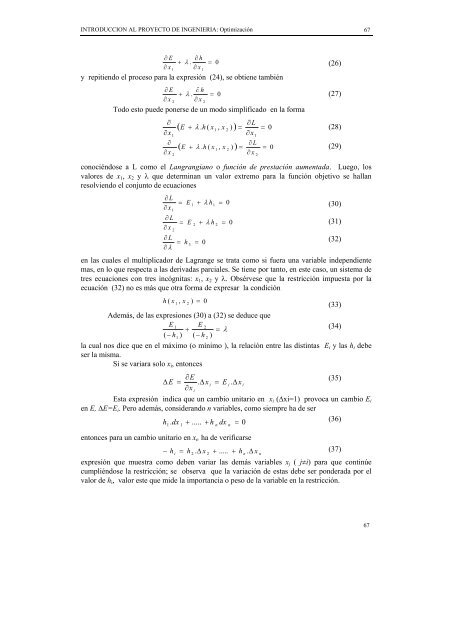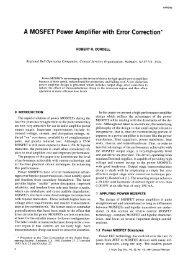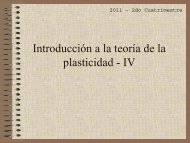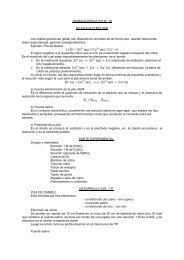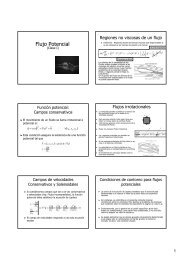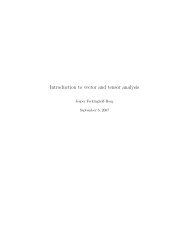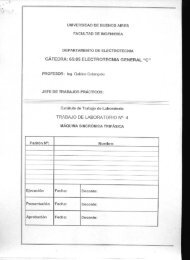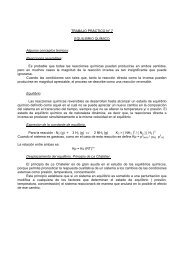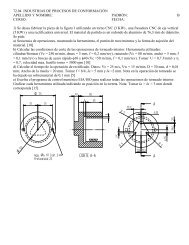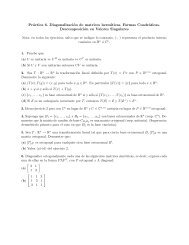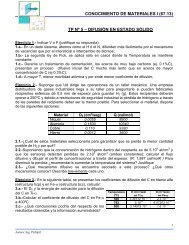Create successful ePaper yourself
Turn your PDF publications into a flip-book with our unique Google optimized e-Paper software.
INTRODUCCION AL PROYECTO DE INGENIERIA: Optimización<br />
∂ E<br />
∂ x 1<br />
+<br />
∂ h<br />
λ .<br />
∂ x 1<br />
= 0<br />
y repitiendo el proceso para la expresión (24), se obtiene también<br />
∂ E<br />
∂ x 2<br />
∂ h<br />
+ λ .<br />
∂ x 2<br />
= 0<br />
Todo esto pue<strong>de</strong> ponerse <strong>de</strong> un modo simplificado en la forma<br />
∂<br />
∂x<br />
∂<br />
∂ x<br />
1<br />
2<br />
( E + λ . h ( x , x ) ) = = 0<br />
1<br />
2<br />
∂L<br />
∂x<br />
1<br />
∂ L<br />
∂ x<br />
( E + λ . h ( x , x ) ) = = 0<br />
1<br />
conociéndose a L como el Langrangiano o función <strong>de</strong> prestación aumentada. Luego, los<br />
valores <strong>de</strong> x1, x2 y λ que <strong>de</strong>terminan un valor extremo para la función objetivo se hallan<br />
resolviendo el conjunto <strong>de</strong> ecuaciones<br />
∂ L<br />
∂ x<br />
1<br />
∂ L<br />
∂ x<br />
2<br />
=<br />
=<br />
E<br />
∂ L<br />
= h<br />
∂ λ<br />
E<br />
3<br />
1<br />
2<br />
+ λ h<br />
=<br />
0<br />
1<br />
+ λ h<br />
2<br />
=<br />
=<br />
2<br />
0<br />
en las cuales el multiplicador <strong>de</strong> Lagrange se trata como si fuera una variable in<strong>de</strong>pendiente<br />
mas, en lo que respecta a las <strong>de</strong>rivadas parciales. Se tiene por tanto, en este caso, un sistema <strong>de</strong><br />
tres ecuaciones con tres incógnitas: x1, x2 y λ. Obsérvese que la restricción impuesta por la<br />
ecuación (32) no es más que otra forma <strong>de</strong> expresar la condición<br />
h ( x 1 , x 2 ) = 0<br />
(33)<br />
A<strong>de</strong>más, <strong>de</strong> las expresiones (30) a (32) se <strong>de</strong>duce que<br />
E 1 E 2<br />
+ = λ<br />
(34)<br />
( − h1<br />
) ( − h 2 )<br />
la cual nos dice que en el máximo (o mínimo ), la relación entre las distintas Ei y las hi <strong>de</strong>be<br />
ser la misma.<br />
Si se variara solo xi, entonces<br />
∆ E =<br />
∂E<br />
. ∆x<br />
i<br />
∂x<br />
i<br />
= E i . ∆x<br />
i<br />
(35)<br />
Esta expresión indica que un cambio unitario en xi (∆xi=1) provoca un cambio Ei<br />
en E, ∆E=Ei. Pero a<strong>de</strong>más, consi<strong>de</strong>rando n variables, como siempre ha <strong>de</strong> ser<br />
h dx ..... + h = 0<br />
(36)<br />
1 . 1 + n dx n<br />
entonces para un cambio unitario en xi, ha <strong>de</strong> verificarse<br />
− h i = h . ∆ x + ..... + h n . ∆ x<br />
(37)<br />
2 2<br />
n<br />
expresión que muestra como <strong>de</strong>ben variar las <strong>de</strong>más variables xj ( j≠i) para que continúe<br />
cumpliéndose la restricción; se observa que la variación <strong>de</strong> estas <strong>de</strong>be ser pon<strong>de</strong>rada por el<br />
valor <strong>de</strong> hi, valor este que mi<strong>de</strong> la importancia o peso <strong>de</strong> la variable en la restricción.<br />
0<br />
2<br />
(26)<br />
(27)<br />
(28)<br />
(29)<br />
(30)<br />
(31)<br />
(32)<br />
67<br />
67


